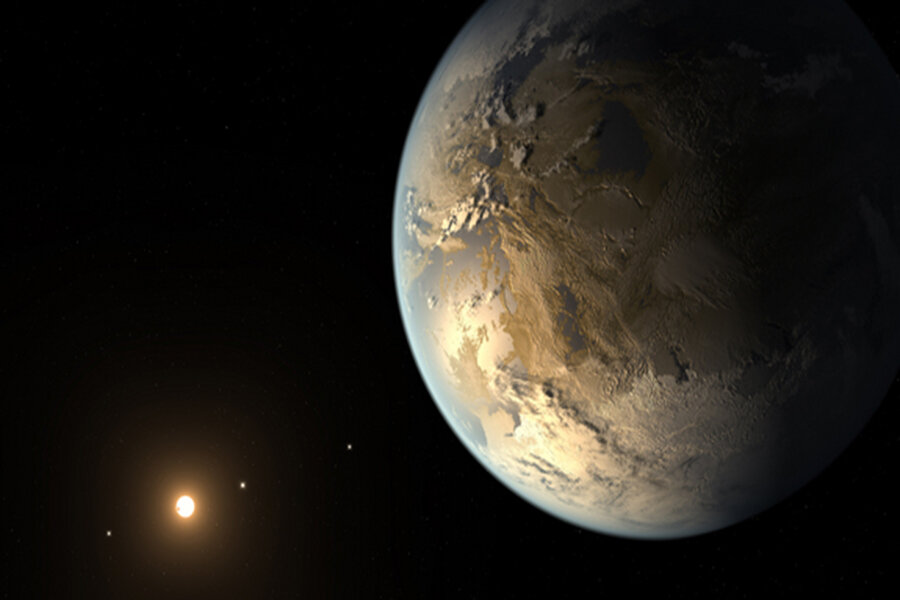Kepler-186f could be 'Earth's cousin,' say astronomers
Loading...
The search for alien life just took a big leap forward.
Astronomers announced today (April 17) that they have found the first "Earth cousin" — a rocky world roughtly the size of Earth called Kepler-186f that may be capable of supporting life as we know it. The discovery further bolsters the emerging view that Earth is not such a unique place, and that habitable environments may be widespread throughout the galaxy, experts said.
"This discovery establishes that Earth-size planets can and do exist in the habitable zones of other stars," Douglas Hudgins, exoplanet exploration program scientist at NASA's Astrophysics Division, told reporters today. (The "habitable zone" is the range of distances from a star in which liquid water could exist on a world's surface.) [New Earth-Size Planet Could Have Water (Video)]
Kepler-186f is an Earth cousin rather than an Earth twin because it orbits a red dwarf (also known as an M dwarf), a type of star much smaller and dimmer than Earth's own sun. The newfound exoplanet is probably one of many Earth cousins out there, researchers said.
"There are 100 billion stars in our galaxy, and seven out of every 10 of them are M dwarfs," said Kepler-186f discovery team member Thomas Barclay, of the Bay Area Environmental Research Institute at NASA's Ames Research Center in Moffet Field, Calif. "This means that most Earth-size planets in the habitable zone will be around M dwarfs, simply because most stars are M dwarfs."
While M dwarfs are quite different than the sun, there's no reason to think that their relatively faint, reddish light could not sustain ecosystems on orbiting worlds, researchers said.
"Kepler-186f still likely receives about one-sixth of the light at wavelengths that plants use for photosynthesis," said Victoria Meadows of the University of Washington. "There are Earth plants that would be quite happy with that."
Because red dwarfs are so dim, their habitable zones lie relatively close in, presenting some potential roadblocks to the emergence or persistence of life.
For example, some possibly habitable M dwarf planets may be tidally locked, showing the same face to their host stars at all times, just as the moon does to Earth. Researchers had previously thought tidal locking would make a planet inhospitable to life, as such a world would have one scorching-hot hemisphere and another freezing cold hemisphere. But more-recent modeling work suggests that air or water currents could transport heat around such planets, evening out their temperatures.
Lying in close proximity to a star also raises a planet's exposure to powerful flares and other star eruptions, which could be damaging to life. But that's not a major problem for all M-dwarf worlds.
"Kepler-186f orbits an older and quieter M dwarf," Meadows said. "It still has flares, but not giant flares, and not a lot of them — a bit like our sun."
In short, rocky planets circling the most common stars in the galaxy may be havens for life.
"There is no good reason at the moment why M dwarf planets could not be habitable," Meadows said.
Astronomers will be hard-pressed to learn much more about Kepler-186f. At 490 light-years away, the planet is too distant for detailed characterization with powerful tools like NASA's $8.8 billion James Webb Space Telescope (JWST), which is scheduled to launch in 2018.
But another NASA mission, called the Transiting Exoplanet Survey Satellite (TESS), should find lots of good follow-up targets after blasting off in 2017. TESS will hunt for planets within 100 light-years of Earth — close enough for JWST to scan their atmospheres for oxygen, methane and other gases that living organisms may have produced.
"Today's result only makes the prospects for future TESS discoveries all the more exciting," Hudgins said.
Follow Mike Wall on Twitter @michaeldwall and Google+. Follow us @Spacedotcom, Facebook or Google+. Originally published on Space.com.
- Earth-Size Planet Kepler-186f, a Possibly Habitable Alien World (Gallery)
- 10 Exoplanets That Could Host Alien Life
- Gallery: A World of Kepler Planets
- New Earth-Size Planet Could Have Water | Video
Copyright 2014 SPACE.com, a TechMediaNetwork company. All rights reserved. This material may not be published, broadcast, rewritten or redistributed.







